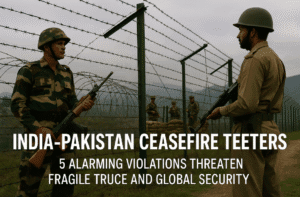India-Pakistan Ceasefire Teeters: 5 Alarming Violations Threaten Fragile Truce and Global Security
A U.S.-mediated truce between India and Pakistan, announced on May 10, 2025, to end the deadliest cross-border clashes in decades, unraveled within hours as both sides accused each other of violations. India reported shelling near Jammu and Srinagar, ordering military retaliation, while Pakistan denied breaches, insisting it remains committed to peace.
The conflict’s toll is stark: 13 civilians killed in Pakistani Kashmir, mass evacuations on India’s side, and villages hollowed out by fear. Global leaders, including the UK’s Keir Starmer, urged restraint, emphasizing the catastrophic risks of escalation between nuclear-armed rivals. Yet decades of distrust, territorial disputes, and domestic political pressures in both nations overshadow diplomacy. For Kashmiris, the cycle of violence feels unending—families huddle in bunkers, schools close, and displacement becomes routine.
Analysts warn that without addressing root grievances or including Kashmiri voices in talks, ceasefires remain temporary fixes. As shells echo anew, the world watches, reminded that peace in South Asia hangs by a thread.

India-Pakistan Ceasefire Teeters: 5 Alarming Violations Threaten Fragile Truce and Global Security
Barely hours after a U.S.-brokered ceasefire aimed to quell the most severe India-Pakistan clashes in decades, the agreement began unraveling as both nations traded blame for fresh violations. The truce, announced on May 10, 2025, sought to halt a dangerous cycle of missile strikes and drone attacks across Kashmir’s contested borders. Yet by nightfall, villages near Jammu and Srinagar echoed with renewed shelling, underscoring a bitter truth: decades of distrust cannot be silenced by diplomacy alone.
A History of Fractured Promises
The Kashmir conflict, rooted in post-colonial divisions since 1947, has seen countless ceasefires crumble. The 2003 agreement, which brought relative calm for years, collapsed in 2020. This latest escalation—marked by advanced drones and precision missiles—signals a perilous new chapter. Analysts suggest domestic pressures in both nations fueled the aggression: India’s government faces elections emphasizing national security, while Pakistan’s leadership grapples with economic crises and militant factions.
The Human Cost of “Peace”
Behind the political rhetoric lies a humanitarian nightmare. In Pakistani Kashmir, 13 civilians were buried in a single day after a mortar strike hit a market. On India’s side, over 20,000 villagers fled under military orders, many recounting harrowing escapes. “We left our homes, our livestock—everything,” shared Asha Devi, a mother of three from Poonch. “Peace? It’s a word for politicians. For us, it’s just survival.”
The Blame Game
India’s military alleges Pakistan-backed militants breached the ceasefire near strategic hilltops, prompting “strong retaliation.” Islamabad denies this, accusing India of fabricating pretexts to justify aggression. U.S. mediators, while urging restraint, privately acknowledge the difficulty of verifying claims in Kashmir’s rugged terrain—a challenge that has doomed past agreements.
Global Alarms and Nuclear Shadows
International reactions reflect escalating fears. UK Prime Minister Keir Starmer stressed “dialogue, not destruction,” while U.S. envoys starkly warned of nuclear miscalculations. Both nations possess over 150 warheads each, with Pakistan’s “tactical” weapons designed for battlefield use. “Every breach inches us closer to a threshold no one wants to cross,” notes arms control expert Dr. Hina Khan.
Kashmiris: Caught in the Crossfire
For locals, ceasefires ring hollow. “We’re pawns in their game,” says student activist Aamir Bhat, whose family has weathered four wars. Displacement and trauma are generational. Trust in external mediation is scant; many recall the 2019 U.S.-Taliban deal that sidelined Afghan civilians. “Unless Kashmiris have a seat at the table, no truce will last,” argues human rights lawyer Meenakshi Ganguly.
A Path Forward?
Sustainable peace demands more than paused hostilities. Confidence-building measures—like joint investigations into violations, trade resumption, or cultural exchanges—could thaw relations. Yet with nationalism surging in both capitals, leaders risk backlash for appearing conciliatory. “The U.S. must pivot from crisis management to addressing core grievances,” suggests former diplomat Shivshankar Menon. “Otherwise, we’re just delaying the next explosion.”
As night falls over Kashmir, families huddle in bunkers, praying shells don’t strike before dawn. The ceasefire’s fragility mirrors a region wearied by promises—and a world holding its breath.
You must be logged in to post a comment.